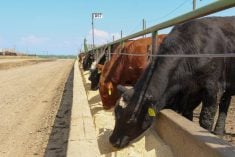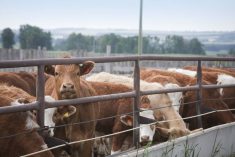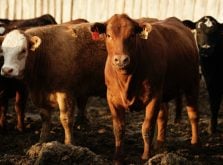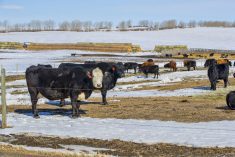The cattle complex ended the 2013 calendar year relatively strong. Alberta packers were buying fed cattle at the yearly highs of $127/cwt to $128/cwt as seasonal strong demand caused AAA wholesale beef prices to reach $208/cwt, up over $30/cwt from year-ago levels. The weaker Canadian dollar along with lower beef production resulted in the elevated price structure.
Feedlot margins have been solidly in black ink over the past month but break even prices remain relatively high for the first half of 2014. Therefore, the price of feeder cattle will be heavily influenced by swings in the fed cattle market. Late in the year, 760-pound Charolais-cross steers were trading for $160 in southern Saskatchewan, up nearly $20/cwt from December of 2012. Weaker feed grain prices and the higher fed cattle values were the main reason for the sharp year-over-year rise in the replacement cattle prices.
Read Also

Harvest wraps up and fall work begins
At the Eppich famly ranch in western Saskatchewan, the fall harvest was successful with few breakdowns, cows and calves have been sorted and a new tractor has arrived
CONSUMER SPENDING
Looking ahead, the cattle market will be sensitive to the beef demand equation as the market trades at historically high levels. Consumers in Canada are contending with record household debt and inflationary factors are bound to influence food prices through 2014. U.S. economy continues to improve with lower unemployment levels but consumer spending has been constrained due to limited disposable income. Record U.S. poultry production will also temper the upside in retail beef prices as the average price-conscious consumer looks to reduce household food expenditures. Given the current environment, producers can be cautiously optimistic for 2014.
Alberta and Saskatchewan feedlot inventories have been up approximately eight per cent this fall. A slowdown in feeder cattle exports in the first quarter of 2014 will likely keep cattle-on-feed numbers slightly above 2013 in the first half of the year. Year-to-date Canadian beef production for the week ending Dec. 7 was 918,214 mt, down two per cent from Dec. 7, 2013. Canadian beef production is expected to be 540,000 mt during the first half of 2014, up about 10 per cent from 2013.
U.S. cattle-on-feed inventories have been running six per cent below year-ago levels throughout the fall and this trend is expected to continue into spring. However, U.S. carcass weights are 10 pounds heavier than last year due to softer corn values. Overall beef production in the fourth quarter of 2013 will come in larger than earlier anticipated and we could see further increases for first-quarter 2014 projections. At this time, first- and second-quarter beef production for 2014 is expected to be down from 2013 by 300 and 400 million pounds respectively.
Larger Canadian beef production will result in a year-over-year increase in beef product exports. Therefore, fed cattle and wholesale beef markets will be sensitive to the volatility in the Canadian dollar. It appears the Bank of Canada will not increase interest rates in line with the U.S. Quantitative easing, a measure used to stimulate spending by the U.S. Federal Reserve, will cause the Canadian dollar to weaken compared to the U.S. greenback. This is one positive factor for the Canadian beef industry.
From the Canadian Cattlemen website: Feeder cattle buyers eyeing risks in new year
Consumer spending is the largest factor influencing beef consumption. U.S. GDP is expected to increase by 2.6 per cent during the first and second quarters which will likely result in a two per cent year-over-year increase in at-home and away-from-home food spending. However, the accompanying chart shows restaurant spending is quite seasonal. Consumers tend to stay at home and generally eat less during the first two months of year after excessive eating in December. By March, spring break and warmer temperatures usually cause people to eat out more often. At-home and away-from-home spending usually trends lower into the summer periods while overall beef production is actually increasing. This results in softer prices for the summer.
Fed cattle prices are expected to follow a similar pattern to that of U.S. consumer food spending. I’m expecting softer values in January and February and then higher prices in March and April. The June live cattle futures are reflecting $5 discount to the April contract so look for lower fed cattle prices in the second quarter.
Feeder cattle prices are expected to hold value through March and then start to weaken in line with the fed cattle market into the summer. Break even on most pen closeouts hovers at $123/cwt over the next four months and if the fed market starts to fade below this level, feeder cattle prices will come under pressure. Barley prices are expected to weaken through the winter as burdensome barley and U.S. corn supplies weigh on the feed grain complex. †
Gerald Klassen analyses cattle and hog markets in Winnipeg and also maintains an interest in the family feedlot in southern Alberta. For comments or speaking engagements, he can be reached at [email protected] or call 204 899 8268.















